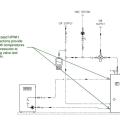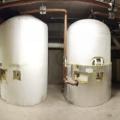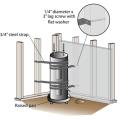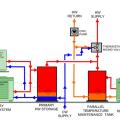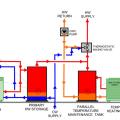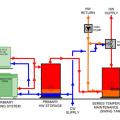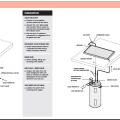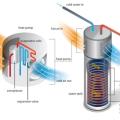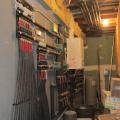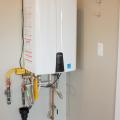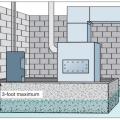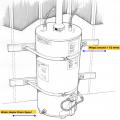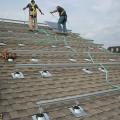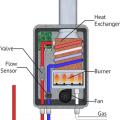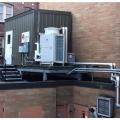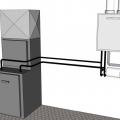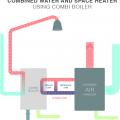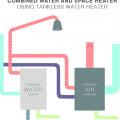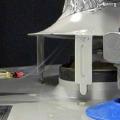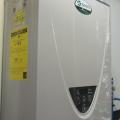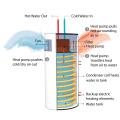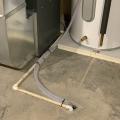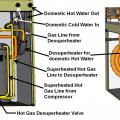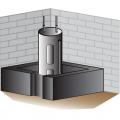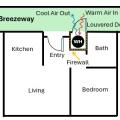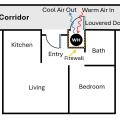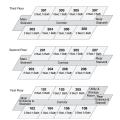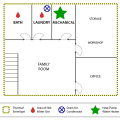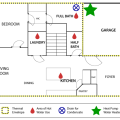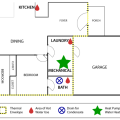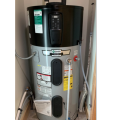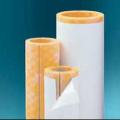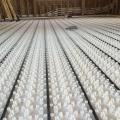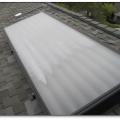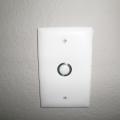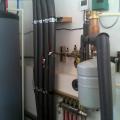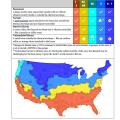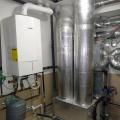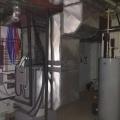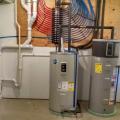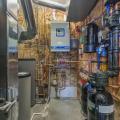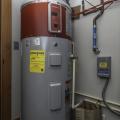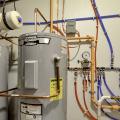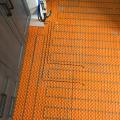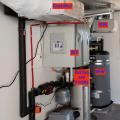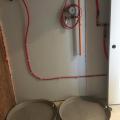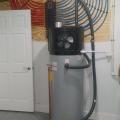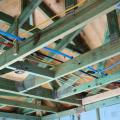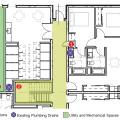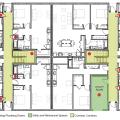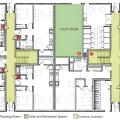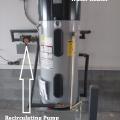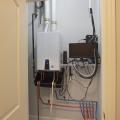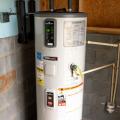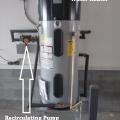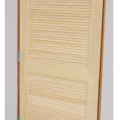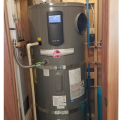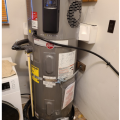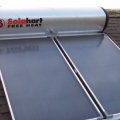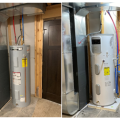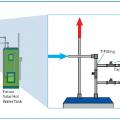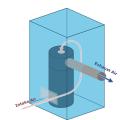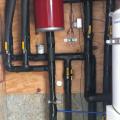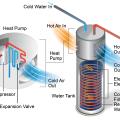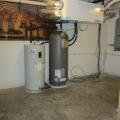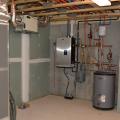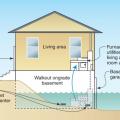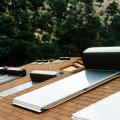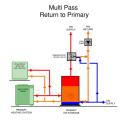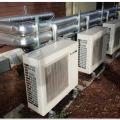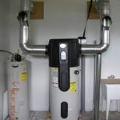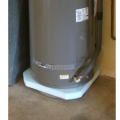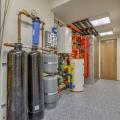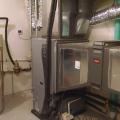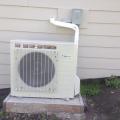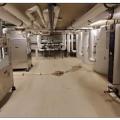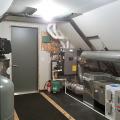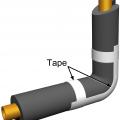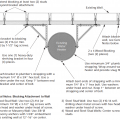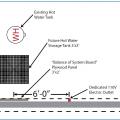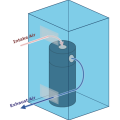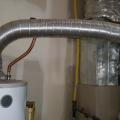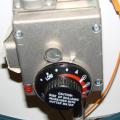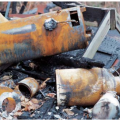Showing results 1 - 148 of 148
Right: dedicated tank connections for HPWH inlet and outlet provide hydraulic separation
A braced water heater is attached to a raised platform that is anchored to the floor
A central heat pump water heating system with a parallel loop tank temperature maintenance configuration uses a multi pass heat pump water heater to provide all the heat for hot water circulation temperature maintenance.
A central heat pump water heating system with a parallel loop tank temperature maintenance configuration uses a multi-pass heat pump water heater to provide all the heat for hot water circulation temperature maintenance
A central heat pump water heating system with a temperature maintenance swing tank configuration uses the water from the primary storage tank to provide most of the heat for hot water circulation temperature maintenance
A flat plate solar hot water system heat potable water in a glass covered collector that sits on the roof.
A heat pump water heater has a small heat pump located on top of the tank which extracts heat from the surrounding air to create hot water.
A high-efficiency gas boiler provides hot water to the faucets, to radiant heating loops in the basement floor, and to a hydro-coil for a central air heating system.
A natural gas 94% efficiency tankless hot water heater provides endless hot water.
A self-sufficient water system for a home could include a rooftop cistern and solar thermal water heater.
A water heater and furnace are protected from flood waters by a concrete floodwall, with a shielded, gasketed door.
A water heater is anchored to 2 x 4 wood blocking that is attached to the wall studs.
All of the pipes are insulated on this high-efficiency 50-gallon heat pump water heater.
Alternative locations of heat pump water heaters in a hypothetical multifamily building using a cluster deployment showing numerous possible deployment options including clusters consisting of pairs on the same floor or on different floors
An indoor water heater should be secured to the wall’s studs to prevent it from moving or tipping over in the event of an earthquake
Basic components of a gas tankless water heater include a high-powered burner, fan, and heat exchanger; condensing gas water heaters also have a secondary heat exchanger and a piped air intake to the sealed combustion chamber
Central heat pump water heaters like this fully packaged system provide efficient, reliable domestic hot water for multifamily buildings; storage tanks are within the enclosure, and the heat pump is seen just outside.
Climate Zones Where a Heat Pump Water Heater can be Installed in Unconditioned Space
Compare gas tankless water heater efficiencies on the Energy Guide labels or look for the ENERGY STAR label
Components of a heat pump water heater
Condensate from this heat pump water heater is routed to a nearby floor drain, shared with the condensate lines from a condensing gas furnace and an air conditioning coil
Floorplan of a heat pump water heater located in a closet in an exterior corridor or breezeway rather than within the thermal envelope of a multifamily dwelling unit
Floorplan of a heat pump water heater located in a closet in an interior corridor rather than within the thermal envelope of a multifamily dwelling unit
Floorplan of a heat pump water heater located in an interior closet with active (ducted) ventilation
Floorplan of a heat pump water heater located in an interior closet with passive ventilation
Floorplan of a hypothetical multifamily building showing corridors and stairwells
Floorplan of a hypothetical multifamily building with hot water First Hour Rating (FHR) requirements (in gallons) noted for each dwelling unit
Floorplan of heat pump water heater located in an exterior closet with transfer grilles in the exterior wall or a louvered door to allow ventilation
Heat pump water heater is installed in the interior closet of a multifamily dwelling unit
Heavy-gauge metal strapping can be used to secure water heaters and other appliances
High-density fiberglass pipe insulation comes with a vapor barrier cover and self-adhesive seam
Hot water for the home’s radiant floor heating system comes from roof-mounted solar thermal panels and an air-to-water heat pump provide.
Hot water recirculation loop runs through an insulated pipe under the home’s concrete slab.
On-demand hot water pumps speed hot water to faucets at a push of a button to limit water waste and save energy.
Passive venting options for a heat pump water heater located in a closet or small room include: a fully louvered door, high and low transfer grilles, or a high transfer grille with a 0.75-inch door undercut
Pipe insulation helps retain heat in the pipes which provide hot water from the air-to-water heat pump for domestic hot water and space heating.
Possible locations of heat pump water heater (HPWH)s in a hypothetical multifamily building using a one-to-one deployment of one HPWH per apartment
Possible locations of heat pump water heaters in a hypothetical multifamily building using a cluster deployment where pairs of dwelling units share a heat pump water heater
Recommended Installation Locations for a Heat Pump Water Heater Based on the Climate Zone of Home
Right - A high-efficiency (95 AFUE) wall-hung gas-fired boiler heats water for the hydro-coil space heating system and also provides a back-up for the solar hot water system.
Right - A home-run (also called central manifold or parallel piping) system distributes hot water directly from a distribution manifold next to the water heater to each fixture using individual small-diameter PEX pipes.
Right - The geothermal heat pump provides hot water for radiant floor heating, domestic hot water, and the air handler for space conditioning upstairs.
Right - The home’s ground source heat pump preheats water for the air source heat pump water heater.
Right - The home’s high-efficiency gas boiler provides domestic hot water as well as in-floor radiant heat, while a high-efficiency heat pump provides cooling and a secondary source of heating.
Right - This 80-gallon heat pump water heater is ducted to pull heat from outside air drawn from the south side of the house and to exhaust cooled air outside on the north side of the house to efficiently heat water without impacting room temperatures.
Right – A ground-source heat pump provides space heating and domestic hot water.
Right – A mat is installed to contain radiant floor loops which distribute hot water from this home’s combi boiler.
Right – An air-to-water heat pump efficiently provides hot water for radiant floor heating.
Right – An air-to-water heat pump provides water and space heating while a heat recovery ventilator provides fresh air that is filtered by the HEPA filter.
Right – Drip pans are installed beneath the home’s 55-gallon heat pump water heater desuperheater tank and back up electric tank water heater.
Right – Hot water from this heat pump water heater is distributed efficiently to each hot water use in the home through a central manifold via PEX piping.
Right – PEX piping speeds hot water directly from the water heater to faucets through the attic in this slab-on-grade home.
Right – Possible Heat Pump Water Heater Locations on a Multifamily Floorplan including an interior corridor, eight apartments, and meeting rooms
Right – Possible Heat Pump Water Heater Locations on a Multifamily Floorplan including interior corridor closets, under-stair closes, and utility rooms
Right – Possible Heat Pump Water Heater Locations on Full Plate Floorplan in a Multifamily Building
Right – The heat pump water heater is equipped with a recirculating pump to push hot water to distant fixtures.
Right – The home’s energy management system is installed in a utility closet next to the tankless water heater.
Right – This heat pump water heater is equipped with a recirculation pump to speed hot water to distant faucets.
Right: Maintenance valves are installed at the inlet and outlet of this central heat pump water heater
Right: This closet door for a heat pump water heater is louvered to allow warm air to enter and exhaust air to leave the closet
Right: This heat pump water heater is in a basement within the thermal boundary but not actively conditioned. It has over 770 ft² of space with easy access to the control panel and clearance for airflow to the air intake (top) and exhaust (side)
Right: This heat pump water heater is installed in a garage next to the furnace where there is a lot of space for accessing the unit, and for intake and exhaust; a foam pad insulates the base; the condensate line is correctly drained and pipe insulation
Right: This heat pump water heater is installed in a laundry room with enough space for the control panel and vents to be clear of obstructions; The HPWH can use heat from the dryer to heat water, but the seismic straps should be lower
Right: This heat pump water heater is installed in a small space so the, intake air is ducted from an adjacent room; the water heater since on a pad of foam insulation and has a good drain line configuration but the waterpipes lack insulation
Right: This heat pump water heater is installed in a utility closet where it can use heat from the clothes washer and heat pump clothes dryer and has access to a floor drain for condensate
Size comparison between two 50-gallon water heaters: a traditional electric-resistance-only water heater on the left and a heat pump water heater on the right
The cool exhaust air from this heat pump water heater is ducted out of the room, inducing warmer intake air to enter through a wall grille
The Energy Guide label on this heat pump water heater shows a first hour rating of 60 gallons; the low Estimated Yearly Energy Cost of $121 reflects the HPWH’s high Uniform Energy Factor (UEF) of (not shown on label)
The heat pump water heater’s evaporator fan provides enough air movement for active ventilation of a small room when the exhaust is ducted; intake air enters passively through a wall grille
The home integrates roof-mounted solar hot water panels with an air-to-water heat pump; both sources feed into an 80-gallon stainless steel tank.
The home’s solar water heating system includes two 30-tube evacuated tube panels and a 120-gallon storage tank with electric back up.
The mechanical room in the insulated basement houses the water heating equipment, including the storage tank for the solar thermal system and the wall-hung boiler as well as the air handler for the hydro coil and high-efficiency (16 SEER) air conditioner.
The small heat pump located on top of the tank on a heat pump water heater extracts heat from the surrounding air to create hot water
The solar hot water system with 80-gallon storage tank should provide all the hot water a typical family needs.
The ultra-efficient air-to-water heat pump draws heat from the outside air to heat inside room air in winter and domestic hot water year-round.
The ultra-efficient ground-source heat pump provides the home with forced-air heating and cooling, and hot water.
The very high efficiency (4.7 COP) ground-source heat pump provides hot water to a tank for radiant floor heat and domestic hot water.
The water heater and other appliances are located above the Base Flood Elevation.
This central heat pump water heating system with a hot water circulation loop that returns to the primary storage tank relies on a single pass heat pump to provide both primary DHW heating and hot water circulation temperature maintenance
This central heat pump water heating system with a hot water circulation loop that returns to the primary storage tank relies on a multi pass heat pump to provide both primary DHW heating and hot water circulation temperature maintenance
This fully packaged/skid-mounted central heat pump water heating system was shipped to the building on a truck and craned into location
This fully specified central heat pump water heating system has four individual outdoor heat pump units plumbed in parallel to indoor storage tanks
This heat pump water heater has been fitted with ducts to exhaust its waste cooling into the occupied living area
This Heat Pump Water Heater has Pipe insulation installed on the hot water line (on left) and on the cold water line (on right)
This heat pump water heater is centrally located in a laundry room so that all hot water uses are less than 15 feet from the tank.
This Heat Pump Water Heater is Sitting on an Insulation Pad to Reduces Heat Losses
This home is equipped with an ultra-efficient (COP 5.7) ground source heat pump, which also provides domestic hot water that is stored in a tank.
This home’s domestic hot water is provided by three systems: solar water heating panels, a heat pump water heater, and an air-to-water heat pump, which also provides hot water to a fan coil.
This home’s ultra-efficient ground-source heat pump provides hot water for space heating as well as domestic hot water for the 50-gallon storage tank.
This is the compact outside unit for an ultra-efficient air-to-water heat pump (COP 4.1) that provides space heating and domestic hot water.
This mechanical room contains both the storage tanks (right) and heat pumps (left) of a central heat pump water heating system
This packaged central heat pump water heating system has the heat pumps on the exterior of the blue enclosure, and the storage tanks, temperature maintenance equipment, mixing valve, and control modules on the inside
This retrofit central heat pump water heater system utilizes the existing water heater as a swing tank to provide temperature maintenance for the hot water circulation loop
This utility room houses a high-efficiency gas boiler to provide hot water for the radiant floor heating system and faucets. It also has a central air source heat pump and an energy recovery ventilator.
This wall-mounted high-efficiency condensing gas tankless water heater has PVC vent pipes and insulated water pipes
Types of heat pump water heaters commonly used in central heat pump water heating systems include single pass units, multi pass units, and integrated units
Use plumbers metal strapping, wood blocking, and shelving brackets to secure a water heater in a corner to prevent tipping during an earthquake.
Use strapping, wood blocking, and shelving brackets to secure a water heater to a straight wall to prevent tipping during an earthquake.
Wall grilles installed high and low on the wall of the heat pump water heater closet allow passive ventilation of a small room with warmer air coming in at the top and cooler exhaust air exiting at the bottom of the wall
Wrap batt insulation around pipe loosely enough not to compress the insulation and secure with wire or tape
Wrong - An unbraced water heater in this home fell during an earthquake; the resulting fire destroyed the home.
Wrong - Water heater flue pipe should be straight for a minimum of 18 inches before turning.
Wrong – The gas water heater is left on during enclosure leakage testing, which could result in dangerous backdrafting of the water heater when the home is depressurized
Wrong – This water heater was not braced; it fell during an earthquake and ruptured the gas line causing a house fire.
Wrong – Two combustion appliances are sharing a flue which could lead to backdrafting if one appliance is updated to a direct vent appliance and disconnected from shared chimney.
Wrong: HPWH inlet and outlet are piped to mixing valve inlet and DCW make up, driving erratic HPWH and mixing valve behavior
Wrong: Not enough space was left in the floorplans for both the heat pump water heater and a duct elbow to be attached to the right side of the water heater (the orange circle outlines the tank; the rectangle shows the space needed for the duct)
Wrong: The exhaust air from one heat pump water heater is blowing into the intake of the heat pump water heater next to it
